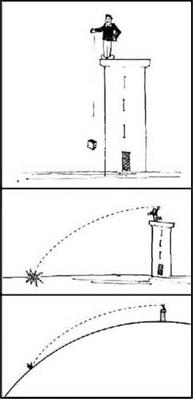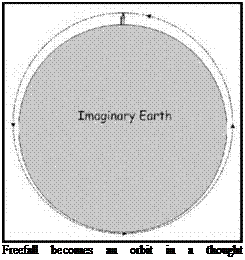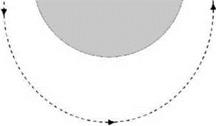AROUND THE WORLD IN 90 MINUTES
The concepts of orbits and weightlessness are often misunderstood by laypeople who harbour the mistaken idea that there is literally no gravity in space. Nothing could be
further from the truth, as gravity binds all matter and light in the universe. To understand how objects move in space, otherwise known as celestial mechanics, one has first to grasp the concept of freefall, because, for much of the time, that is the condition of everything in space. Our communications, weather and TV satellites are in constant freefall around Earth, as is the Moon. Earth itself, along with the other planets, is in a permanent state of freefall around the Sun, which itself freefalls around our galaxy. Even the immense Milky Way galaxy that we inhabit is freefalling along with a collection of others in our local group of galaxies in an eternal gravitational dance that is essentially no different to the freefall experienced by a stone dropped off a bridge into a river.
The crucial ingredient that transforms freefall from a short-term descent that ends in a messy impact, into the essential element of an orbit, is speed, very high horizontal speed. A common thought experiment that explains the concept of the orbit is one that invokes a perfectly smooth, airless Earth with an imaginary tower. At the top of the tower is our intrepid imaginary experimenter, presumably wearing an imaginary spacesuit, whose task is to fling an object to the ground and watch how
 it travels before it impacts Earth’s surface. Let us imagine that this object is a box containing beads, so that the effects of weightlessness can be observed, at least from the perspective of our mind’s eye.
it travels before it impacts Earth’s surface. Let us imagine that this object is a box containing beads, so that the effects of weightlessness can be observed, at least from the perspective of our mind’s eye.
In this scenario of the mind, our experimenter begins by simply dropping the box from the tower. The box accelerates by gravity’s pull until it hits the ground. The beads within the box experience an identical acceleration such that not only is the box falling, but so are the beads. In our mind’s eye, looking within the box, the beads can be seen freely floating around between the walls of the box and so they appear to be weightless. Viewed from outside, however, they are falling with the box until they both meet their end directly below the point from which they were dropped.
The next incarnation of the thought experiment deals with what happens when, instead of just dropping the box, our experimenter throws it horizontally. For the few hundredths of a second that the throw is being executed, the beads are pushed against the back of the rapidly accelerating box and they experience whatever g-forces the experi – The dynamics of falling objects in a menter’s arm can achieve until the throw is thought experiment. complete. Once the box has left the thrower’s
hand and is coasting, it follows a curved path to the ground that can be resolved into two components: horizontal and vertical motion. Following the first law of motion devised by Isaac Newton, once horizontal velocity has been imparted by the throw, it is maintained until something causes it to change; and there is nothing in our thought experiment to do that because we have exorcised the effects of the atmosphere. In the vertical direction, however, the gravitational effect of Earth exerts the same force on the box as it did in the previous scenario, pulling the box and its beads to their untimely end on our imaginary airless surface. By combining these two velocities, we arrive at a curved path as the acceleration of gravity takes our subjects to their doom. Inside the box, the beads float around, apparently weightless and unaware of their fate. Although the box now follows a longer distance in its curved path to the surface, the time taken to reach the surface is essentially the same as if it had been dropped.
 The next case for our thought experiment above our idealised Earth is where arrangements are made to throw the box at a far greater speed than is achievable by a human arm; say something of the order of a few thousand kilometres per hour. Traditionally in these kinds of mind games, this can be achieved by an immense, imaginary cannon. Once the cannon has done its rather violent job of quickly accelerating the box, we see the same two influences affect the box’s flight. Gravity accelerates the box and its beads down to Earth while the constant horizontal speed takes it away towards the horizon. Again the result is a curved path to the surface. Once the beads within the box have recovered from their sudden acceleration, they are once more seen to float freely and exhibit what we call weightlessness. However, on this occasion, the flight lasts rather longer than in the previous cases. The box’s horizontal speed is so great, and so much distance is being gained as it drops, that by the time it has fallen the height of the tower, the curvature of Earth has dropped the surface level a little, and so the box has further to fall to reach the surface.
The next case for our thought experiment above our idealised Earth is where arrangements are made to throw the box at a far greater speed than is achievable by a human arm; say something of the order of a few thousand kilometres per hour. Traditionally in these kinds of mind games, this can be achieved by an immense, imaginary cannon. Once the cannon has done its rather violent job of quickly accelerating the box, we see the same two influences affect the box’s flight. Gravity accelerates the box and its beads down to Earth while the constant horizontal speed takes it away towards the horizon. Again the result is a curved path to the surface. Once the beads within the box have recovered from their sudden acceleration, they are once more seen to float freely and exhibit what we call weightlessness. However, on this occasion, the flight lasts rather longer than in the previous cases. The box’s horizontal speed is so great, and so much distance is being gained as it drops, that by the time it has fallen the height of the tower, the curvature of Earth has dropped the surface level a little, and so the box has further to fall to reach the surface.
In successive versions of our thought experiment, we increase the power of the cannon higher and higher, reaching ever greater starting velocities. As we do so, we find that the effect of Earth’s curvature becomes ever greater, increasing the time that the box coasts in freefall until impact. In every case, the beads gaily float around inside the box and appear to be weightless to anyone who could look.
Eventually our thought experiment reaches a special case where the horizontal velocity of the box is so high that it manages to fall in a
great ballistic arc all the way to the opposite side of our perfectly smooth, imaginary Earth without hitting it. It might be expected that it would simply travel a little further before meeting its doom but we run thought experiments to illustrate when nature does not act as we expect. By the time the box has reached the opposite side of the planet, the antipode, it not only has the horizontal velocity imparted by the cannon, but has also gained additional momentum by virtue of the speed of its fall towards Earth. This means that the box not only continues around Earth, but also climbs back up to the altitude from which it was launched, much like a pendulum that, having fallen to the lowest point in its arc, has the momentum to continue to the top again. There is no case where the horizontally-fired box will impact the surface beyond the antipodal point. In our idealised scenario, our experimenter had better watch out, because about 90 minutes after he fired it from his cannon, his box will come whizzing by at the same speed, about 28,300 kilometres per hour, that it had when it was first set on its journey. In all this thought experimentation, we must, of course, not only ignore the effect of the atmosphere, we must also forget for the moment that Earth is rotating. The box has completed an orbit of Earth during which the beads within it experience the same weightless effects of freefall that they experienced in all the previous cases.
Having achieved an orbit, there are three further cases of orbital travel we can look at. The basic orbit just illustrated has two important features that are typical of nearly all orbits where a small body revolves around a much larger one. At the point where it just missed the surface on the opposite side of the planet, it was at its lowest altitude. For an orbit around Earth, this is termed the perigee. The point at which it was launched was, in this case, the highest point in its Earthly orbit, which of course is the height of the tower on which the cannon was fitted, and is termed the apogee. This lop-sided trajectory around a large body is called an elliptical orbit.

 Continuing with our thought experiment, there is a specific case with a slightly higher starting speed than the previous example, where the box maintains a constant altitude. The curvature of Earth’s surface is falling away in exact sympathy with the box’s path, making the two concentric and the orbit becomes circular at the height of the tower. Again, the beads float around weightless within the box, and again, our space – suited experimenter needs to keep his head down as the box will whizz by in about 90 minutes.
Continuing with our thought experiment, there is a specific case with a slightly higher starting speed than the previous example, where the box maintains a constant altitude. The curvature of Earth’s surface is falling away in exact sympathy with the box’s path, making the two concentric and the orbit becomes circular at the height of the tower. Again, the beads float around weightless within the box, and again, our space – suited experimenter needs to keep his head down as the box will whizz by in about 90 minutes.
Finally, we need to look at what happens when the experimenter adds The orbit in a thought experiment is extended. even more charge to his hypothetical
cannon and fires the box at an even higher starting velocity. In this situation, the box has more impetus than is needed for a circular orbit and this extra momentum straightens out the flight path a little, causing it to rise from Earth as it moves away from our imaginary tower. However. like a ball thrown vertically into the air. the box slows down as it rises away from the planet until it gets to the opposite side of Earth where it reaches an apogee. The box’s vertical travel, i. e. its movement away from Earth’s surface, has come to a stop and it gains no more height. Once its remaining horizontal speed has taken it past apogee, it continues on its path, descending all the time and regaining all the speed it began with until, at the tower. it reaches its perigee at the height of the tower, ready to repeat its elliptical orbit. In this, as in all the previous cases, the beads within our box float around in the same state of apparent weightlessness that they experienced when on their way to destruction in our first example. The orbit is simply a special case of freefall in a universe where gravity is king.
Applying this rather fun analysis to real life, the Saturn launch vehicle was both our cannon and our tower. It lifted our box. the Apollo spacecraft, to an altitude beyond the sensible atmosphere where the air could not impede it. and accelerated it horizontally until it had enough speed to fall all the way around Earth. Instead of beads, we have three crewmen who found themselves weightless and able to float around in their cabin until another force pushed them back in their scats.
The elliptical nature of orbits was first w’orked out by Johannes Kepler in the early seventeenth century. His first law of planetary motion states that all planets move in ellipses with the Sun at one of the tw;o foci of their ellipse. The same holds true for spacecraft orbits with Earth, the Moon or other planet at one focus. And although the crew are still subject to gravity, they are weightless.










